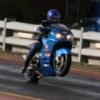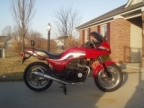- Posts: 1397
- Thank you received: 7
mono shock under the bike
- 77KZ650
-

- Offline
- User
07 MDP Rookie of the Year
01 ZX-12R street/drag bike. 8.97 @155.7 pump gas, dot tires, no bars, no power adders. top speed in the 1/4: 161MPH
Please Log in or Create an account to join the conversation.
- 79MKII
-

- Offline
- User
- Love Them Kaws!
- Posts: 2494
- Thank you received: 43
The Kaw List:
Current: 79 KZ1000 A3 MKII, 78 KZ1000 A2, 78 KZ1000 Z1-R, 78 KZ650 SR, 80 KE175
Former: 03 KLX400SR, 99 ZRX1000, 82 KZ750 LTD, 80 KZ1000 A4 MKII, 80 KZ1000 LTD, 78 KZ1000 A2, 74 H-2 750 Triple, 78 KL250
Please Log in or Create an account to join the conversation.
- koolaid_kid
-

- Offline
- User
- Posts: 783
- Thank you received: 99
Post edited by: koolaid_kid, at: 2006/03/10 12:52
1983 GPz 750
810 Wiseco, Kerker, K&N, DynoJet S3, Accel, Progressive, etc.
Please Log in or Create an account to join the conversation.
- twowheeledterror
- Visitor
get two pieces of tubing. One should slide into the other.
Now, slide them together with the pipes perfectly vertical. If they are correctly sized it should slide in with very little effort.
Now do the same thing with them horizontal. Gravity is pulling them down with your hands as a pivot point, and you will get more friction off of the top walls (top outside of the inner and inside of the outer) as you slide them together.
That's my point.
Please Log in or Create an account to join the conversation.
- steell
-

- Offline
- User
Take the spring off a standard shock and compress it (THE SHOCK) by hand while holding it vertical and then horizontal.
Can you detect any difference in the amount of force required to compress or extend the shock?
I have done this with automotive shocks and could not tell the difference.
There probably is some additional friction involved, but I suspect the torque required to overcome that additional friction is measured in micro ounces.
Post edited by: steell, at: 2006/03/10 16:29
KD9JUR
Please Log in or Create an account to join the conversation.
- twowheeledterror
- Visitor
A better test
Take the spring off a standard shock and compress it by hand while holding it vertical and then horizontal.
Can you detect any difference in the amount of force required to compress or extend the shock?
I have done this with automotive shocks and could not tell the difference.
There probably is some additional friction involved, but I suspect the torque required to overcome that additional friction is measured in micro ounces.
That would make complete sense if there was just a spring and no other parts.
Please Log in or Create an account to join the conversation.
- Duck
-

- Offline
- User
- e vica na i sau na ga
Not trying to hijack, but has anyone grafted the bandit 1200 rear end on to a kz1000 frame? Monoshock and wider swingarm already together. Saw the bandit carcass at the boneyard last weekend.
-Duck
Please Log in or Create an account to join the conversation.
- twowheeledterror
- Visitor
TWT, I know see what you are saying about friction except that gravity acts equally on the shock not on the center of it (which would cause friction) so I am still convinced that you may be slightly incorrect here. Nothing like a good physics discussion.
Actually, it doesn't. The shock is anchored on the ends, and it pivots from those points.
Please Log in or Create an account to join the conversation.
- steell
-

- Offline
- User
If we are going to be concerned about the minute increase in force required due to friction, then should we not also factor in the effect of gravity?
In a vertical shock mounting the bottom (heaviest part) of the shock adds to the unsprung weight, while in the horizontal mounting the unsprung weight would be reduced.
I think we are discussing things that make no practical difference anyway


KD9JUR
Please Log in or Create an account to join the conversation.
- twowheeledterror
- Visitor
Ok, I edited my previous post to make it clear that I was talking about compessing the shock and not the spring. :laugh:
If we are going to be concerned about the minute increase in force required due to friction, then should we not also factor in the effect of gravity?
In a vertical shock mounting the bottom (heaviest part) of the shock adds to the unsprung weight, while in the horizontal mounting the unsprung weight would be reduced.
I think we are discussing things that make no practical difference anyway
I think we are arguing semantics to argue semantics.
Please Log in or Create an account to join the conversation.
- 79MKII
-

- Offline
- User
- Love Them Kaws!
- Posts: 2494
- Thank you received: 43
The Kaw List:
Current: 79 KZ1000 A3 MKII, 78 KZ1000 A2, 78 KZ1000 Z1-R, 78 KZ650 SR, 80 KE175
Former: 03 KLX400SR, 99 ZRX1000, 82 KZ750 LTD, 80 KZ1000 A4 MKII, 80 KZ1000 LTD, 78 KZ1000 A2, 74 H-2 750 Triple, 78 KL250
Please Log in or Create an account to join the conversation.
- twowheeledterror
- Visitor
Remember that the shock dampening does not occur from friction of the shaft against the seal (or any other item). The shock movement is dampened by the controlled movement of fluids or gas through internal passages. The seal on the shaft is the only point where gravity would add force, and although it probably does, it would be so small it wouldn't make a noticeable difference. There is only that very small area of friction where the "two tubes" example would apply. Other than early 60s and 70s motocrossers, I don't know of any motorcycles that use a perfectly vertical shock anyway. Even our KZ's are tilted slightly. Many of todays bikes use near horizontal shocks. Some are even under the bike, like the Buells for example. :side:
Oh let's not get into the concept of fluid dynamics. :lol:
Please Log in or Create an account to join the conversation.

